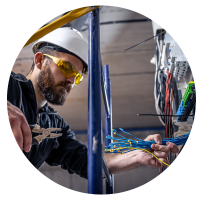New year, new career – seems to be the general trend after the 2020 we have just all had.
Unless you have been one of the lucky ones most people have found themselves in the position of needing a new job and quite often in a new industry.
The trades have been greatly unaffected from the pandemic as the need to continue to provide infrastructure and services has allowed most in the trades to continue working. Most finding 2020 the busiest year they have ever had.
In this latest series of blog posts we are going to look at how you actually become an electrician and how you can start a new career as an electrician.
The million-dollar question which we get asked every day:
How do I become an electrician?
followed by:
What qualifications do I need?
Does it take a long time?
Do I need to be Part P?
Can I become Part P qualified?
I’m too old to become an apprentice – what shall I do?
In this blog post we are going to look at Part P of the Building Regulations and what is Part P in relation to becoming an electrician.
Part P is an approved document within the Building Regulations, there are quite a few with a handful relating to electrical work within a dwelling.
The P was used apparently as this was the next letter free when forming the approved documents. Our document is actually called:
Electrical Safety
The other documents that relate to or are considered to be relevant to an electrical installation are:
Approved Document A – Structure
Approved Document B – Fire safety
Approved Document C – Site preparation and resistance to contaminates and moisture
Approved Document E – Resistance to sound
Approved Document F – Ventilation
Approved Document G – Sanitation, hot water safety and water efficiency
Approved Document K – Protection from falling, collision and Impact
Approved Document L – Conservation of fuel and power
Approved Document M – Access to and use of buildings
Within the industry there is a big misconception about Part P: being Part P qualified and being able to make Part P notifications – Unfortunately, these are not the same thing.
Being Part P qualified: City & Guilds awards a qualification in Part P of the Building Regulations – 2393-10 Level 3 certificate in the Building Regulations for Electrical Installations in Dwellings.
MJ Electrical Training offers this qualification for £198.00 inclusive. Full access to our online tutorial with 1 x attempt at the City & Guilds 2393 examination at a centre near you.
This qualification is worth its weight in gold and demonstrates knowledge and understanding of your obligations electrically within a dwelling – without this qualification it would be difficult to say you are Part P qualified and Mr & Mrs Smith / Joe public see this as a requirement of their electrician.
Personally, I can say this is the only qualification I have ever been asked to show. We put a lot of very competent and qualified electricians through this qualification every month. This qualification helps generate lots of business through letting agents, landlords and housing associations.
However, within Part P there are two type of electrical works you can undertake:
- Non-notifiable
- Notifiable
Should you complete notifiable works within a dwelling you will not be able to make a Part P notification on the works you have just completed with this qualification alone. You will need to join one of the Government approved Part P competent persons schemes (CPS schemes).
A Part P notification is also known as signing work off.
The Ministry for Housing, Communities and Local Government authorises competent person schemes
You are probably more familiar with some of the CPS schemes from other industries such as Gas Safe or Fensa. In the electrical world we have the following:
Stroma
Napit
Elecsa
NICEIC
Becoming a member of one of the above schemes enables its members to make Part P notifications for notifiable works within dwellings through the membership to the scheme. The membership is generally annual with an assessment made of works completed each year showing the standard of your work and to ensure it complies with the Building Regulations & Wiring Regulations.
Membership to a CPS scheme also gets you automatically included in the Electrical Competent Person Register. This register is designed to be a place for households to find registered electricians in their area.
If you are looking to become an electrician and unsure where to turn or how to start please don’t hesitate in getting in touch.


